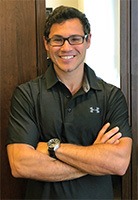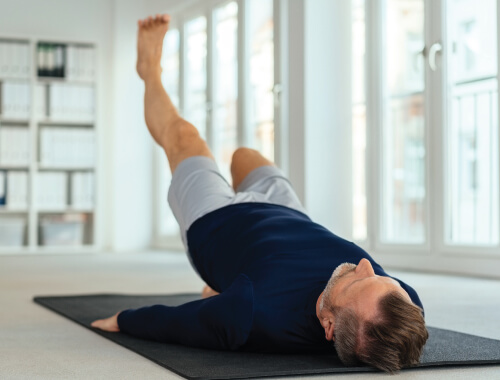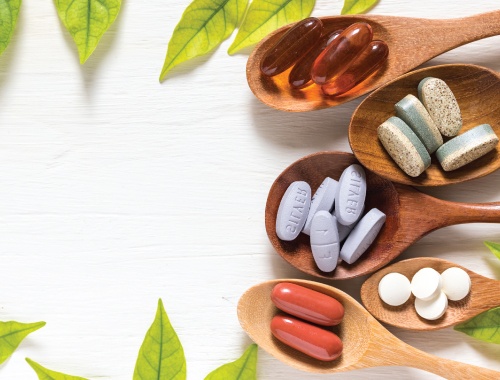
You can, you should, and if you’re brave
enough to start, you will.
Dan Millman
The aging process brings on a host of changes throughout the body. In particular, one of the most pronounced shifts we see through the years is a substantial decrease in testosterone. The decline begins in our 30s with a 1-2% decrease every year thereafter. The sharpest decline is typically seen around our middle ages, during the mid-50s to early 60s.
While the inevitable changes brought on by aging might at first seem to merely be a fact of life for which nothing can be done to combat, at Cenegenics we feel differently. There are two ways we can look at time. We can sit back and let the punches connect, allowing our dwindling testosterone levels to slowly but surely diminish muscle mass, metabolism, and overall wellbeing. Or, we can take matters into our own hands and fight back. In the following guide, we’ll show you how to do just that.
Aside from the aging process itself, there are many factors that contribute to diminishing testosterone levels. While we may not be able to change our age, there are ways to address the other factors within our control—no matter where we are in life. Practical and effective measures can be incorporated into a healthy lifestyle for everyone. And, while testosterone is critically important for men’s health, these principles apply to both males and females, as both rely on this hormone to maintain muscle mass and a strong metabolism, two key factors that help us maintain optimal health as we age.
On the surface, improving testosterone naturally seems to be a losing battle for many people. However, research has indicated that there are many ways in which a person can take the fight against age into their own hands. If you’re wondering how to naturally increase testosterone, start by taking a look at your overall lifestyle. The most powerful tactics for boosting this essential hormone align precisely with those that support overall wellness, including regular exercise, an optimized diet, and healthy sleep practices. We’ll explore each of these pillars in greater detail below.
You’ve probably heard this before, and chances are you’ll hear it again: A body in motion stays in motion, and a body at rest stays at rest. We’re not talking about physics here, though—we’re talking about your health.
When we exercise, our body responds and adapts. Believe it or not, stress is very healthy for the body—as long as it’s the right type, which in this case is physical stress. Physical stress brought on by working out is recognized by the body, which then activates the proper physiological response to adapt.
During exercise, there is an acute increase in both testosterone and growth hormone. Testosterone and growth hormone are our main anabolic hormones, and they increase in the presence of increased physical stress. Research has shown that intensity, resistance, and consistency are the keys to maintaining healthy testosterone levels through training. Here are the ways in which you can maximize the intensity, resistance, and consistent progression of your exercise routine to elicit testosterone growth.
Exercise is one of the most powerful tools we have in our arsenal for improving health, minimizing the risk of chronic illness, and, of course, naturally increasing testosterone. By now, the advantages of regular exercise are widely understood by medical practitioners. Cardiovascular activities, such as running and cycling, boost respiratory health. Functional training, which can include Pilates and yoga among other exercises, can increase stability and structural control. And weight or resistance training, in which we use gym equipment, free weights, or our own body weight, can help us increase:
Resistance training also provides an added benefit that often goes overlooked: Weight training that provides an unaccustomed stimulus to the body can lead to a spike in anabolic hormones such as testosterone and growth hormone.
When we weight train, the body is loaded with a stimulus it is not used to, also known as mechanical loading. For instance, if your body is unaccustomed to hoisting weight over your head but you incorporate overhead presses into your weight training regimen, the body will be unfamiliar with this stimulus. When the mechanical load against the body increases, the body must respond accordingly. It does so by increasing what’s called “motor unit recruitment.”
Motor units are critical muscle components that work to build force. These complex components are made up of different types of fibers which attach to bones with connective tissue. They are made up of nerve cells that innervate a group of skeletal muscles. The nerve cells within our motor units receive signals from the brain which stimulate the corresponding muscle fibers.
The more motor neurons that innervate the muscle fiber, the more efficient the muscles become. This greater efficiency leads to increased adaptation from weight training. At the same time, the external load also forces the body to release anabolic hormones. This is due to the increase in stress on the body. Stress indicates to the body that a response is needed, most of the time in response to catabolism (breakdown of some kind). In order to manage the stimulus, testosterone and growth hormone are released to combat the force generated and the pending catabolism.
The most effective strength exercises for increasing total testosterone release during training are compound movements. These exercises are defined as “multi-joint movements” as they recruit multiple muscle groups for the most efficient and impactful workout. Some powerful multi-joint movements for increasing testosterone include:
Because all of these movements require the use of multiple joints, they effectively maximize testosterone release. As previously mentioned, the greater the stimulus the greater the neurological response. The greater the neurological response, the greater the muscular innervation. And finally, the greater the muscular innervation, the greater the testosterone release.
With that being said, single-joint exercises are also effective for increasing muscle mass. These, too, will elicit a testosterone increase and are effective for isolating single muscle groups. Consider incorporating the following single joint exercises into your workout routine:
These exercises are effective because they strengthen the individual components that help the whole body train optimally. However, in order to maximize testosterone release and training response, progressive overload of large muscle groups should be the priority.
When taking on a training routine, target multi-joint movements, but do so slowly. Adding weight too quickly to compound movements can be very dangerous and lead to serious injury. Just using all of these muscles at once, even with light to moderate weight, will initiate anabolic hormone release. Be sure to work with your nutrition/exercise counselor to ensure proper technique and programming for your individual needs and fitness levels.
While weight training is most effective for increasing testosterone, cardiovascular exercises can also support ideal testosterone levels by helping you maintain healthy fat levels. Yet, because achieving optimal health requires a complex balance among exercise and nutrition practices, it’s also important to make sure you’re fueling your body to support both optimal testosterone and demanding workouts. In the following section, we’ll take a closer look at some key nutrition principles for supporting healthy testosterone levels.
As always, nutrition and exercise work together as the perfect crime-fighting duo to combat the effects of aging. When it comes to boosting testosterone naturally, the nutrition/exercise balance is no different. When we improve our exercise routine, a concurrent change in nutrition needs to occur as well. This will ensure that performance and recovery are maximized. Explore some general nutritional guidelines for testosterone health below.
Protein intake is absolutely essential to building muscle mass. In order for muscle to grow, there must be a positive nitrogen balance. This means that we need to be building more than we are breaking down. As discussed above, testosterone is anabolic and will therefore thrive in a nutrition plan high in quality protein.
When protein levels are too low, we risk falling into a negative nitrogen balance. This leads to catabolism or breakdown. Lower levels of protein will reduce anabolism which reduces exercise performance and recovery and, as a result, testosterone production. In order to maintain an anabolic environment needed to support testosterone growth, we must take in ample protein.
Healthy sources of protein include lean poultry and meat, beans and legumes, and nuts. Of course, protein isn’t the only macronutrient to focus on for healthy eating, which is why working with a nutrition specialist who can help you master a balance is so widely recommended. We’ll discuss the other macronutrients, carbohydrates, and fats next.
As most of us already know, determining the right level of carbohydrate intake for our bodies can be tricky. When it comes to this macronutrient, there are many factors to consider.
At Cenegenics, one of our main goals is to improve insulin sensitivity, blood sugar regulation, and hemoglobin A1c. Many of these objectives can be achieved largely through regulating carbohydrate intake. In fact, carbohydrates play a significant role in our overall health. However, the amount and type of carbohydrates we need for fuel varies based on many individualized factors. Before embarking on a new nutrition plan, be sure to consult your Cenegenics physician and exercise nutrition coach about the best carbohydrate structure for you.
Now, let’s say that you’ve established a strong training routine and have your blood sugar numbers well under control. Carbohydrates have a very large role in sustaining energy, exercise performance, recovery, and therefore, testosterone. When the body undergoes substantial carbohydrate depletion, it seeks out other fuel sources to use as energy. Of course, fat is one of them but, eventually, if overall calorie intake drops too low, protein becomes one as well. This breakdown of protein also results in catabolism and can lead to decreased muscle mass, metabolism, and strength. Again, it is thus critically important to have an expert help you establish the nutritional plan that corresponds with your precise workout structure and physiological needs.
Here are general guidelines on how to choose the right kinds of carbohydrates for your activity level.
If you perform light cardio a couple of times a week, your best bet is to stick with vegetables and the occasional high-fiber fruit, such as apples, pears, and oranges. These foods are high in micronutrients and fiber which makes them ideal for the lower-intensity activity. This type of exercise is not very demanding which means carbohydrates will not be the primary driver for energy production.
If you practice moderate-intensity training including moderate cardio and two days of lightweight training, you may have a greater need for carbohydrates. This type of training would require moderate-glycemic carbs, such as berries and oranges. These carbohydrate sources should be consumed immediately after training along with a protein source. This approach will help you make the most of the natural insulin spike you produce during and after training, allowing you to use carbohydrates efficiently while building muscle protein.
The word “fat” has garnered a bad reputation over the years. Recently, however, nutrition experts have encouraged us to embrace the powers of healthy fat. While healthy fat can help you maintain healthy cholesterol levels, its benefits extend even further. Cholesterol is the precursor for testosterone formation. Without adequate levels of healthy fat intake, we may suffer from low high-density lipoproteins (the healthy cholesterol). With low levels of healthy cholesterol in the body, our baseline production of testosterone can actually be blunted and decrease over time. To maintain healthy levels of good cholesterol, healthy fats should be added to your diet, such as:
All of these sources of fat contain high levels of quality nutrition that can help maintain a healthy cholesterol profile in the body. This, in turn, can also help you maintain healthy, natural testosterone levels. With that said, fats are very high in calories so always be aware of proper portion size for total calorie intake. Again, work with your nutrition and exercise team to establish a meal plan that works for you.
While exercise and nutrition are among the most important factors for regulating testosterone and supporting overall health, there’s one frequently overlooked yet critically important component to consider: sleep.
Sleep deprivation is one of the main causes of diminishing health over time. When we sleep, the body undergoes a recovery process that, when reduced, can create a cascade of severe health-related issues.
Within the first two hours of quality REM sleep, there is a significant increase in growth hormone and testosterone release. As stated above, maintaining healthy levels of these two anabolic hormones will reduce muscle protein breakdown. In general, seven to nine hours of sleep is typically recommended, which adds up to around three or four full REM cycles. Each REM cycle provides further recovery for the body, including a reduction in cortisol.
Unfortunately, pulling all-nighters, slamming down caffeine, and working our fingers to the bone are behaviors that are often worn as a badge of honor in our society. In reality, these unhealthy practices are among the worst things we can do for our health. Forcing the body to push through sleep deprivation initiates a survival mode. This prompts the body to attempt forced sleep by increasing cortisol, telling you that it is time to slow down. The more we push through this catabolic warning, the more our unhealthy stress levels and inflammation increase.
In a study conducted by Leproult et al, college students were placed under a week of sleep deprivation. First, however, students received eight hours of sleep per night for a week, during which their testosterone levels were measured daily. For the following eight days, the students slept five hours per night, and testosterone was measured similarly. At the end of the eight days of sleep deprivation, each student saw a decline in testosterone of 10-15%. That is a massive change in less than a week and a half, and these students were in their early 20s. Imagine what’s happening if you’re in your mid-50s and you’ve been sleep-deprived for most of your adult life!
Ultimately, cortisol and testosterone work like a see-saw: when one goes up too much, the other one goes down. We can combat the rise in cortisol through healthy nutrition and sleep. However, when those two things are neglected, testosterone levels face a losing battle against cortisol from which they may not recover. Therefore, testosterone drops, leading to decreased energy, metabolism, muscle mass, and even joy. It is very common to feel anxiety and depression when you’re sleep-deprived because that’s how your body feels when it is perpetually in breakdown mode.
So, do your body a favor: leave the office early, get away from the screen, and get some shut-eye. Ample sleep is essential not only for optimal testosterone levels but for your health as a whole.
Improving any one of these areas for increasing testosterone naturally may be beneficial in itself. However, the combined effect of all of these factors will provide the greatest boost in testosterone and overall wellness. Health is like a building that is held up by pillars: when all of the pillars are intact, the building will stand strong. Remove one pillar, and the structure becomes weaker. Remove another, and the same happens. Remove all of them, and the whole structure collapses.
When we work ourselves to the bone, we are unaware of how much damage occurs within our bodies every day. To maintain healthy testosterone and overall wellness, you must incorporate the recommendations described within this guide. As a brief recap, here are some key principles covered herein:
As the leaders in personalized age defiance, Cenegenics provides the highest level of support for our patients. We’re here for you at every step, whether your goal is to increase testosterone, feel more energized, or improve your health overall. With that said, it’s up to you to make the change. The consistent effort you put into the program will enhance your experience as well as our ability to help you. Our expert team will provide all the tools you need and set the path. We’ll be beside you the whole way, encouraging you to move forward towards the life you want to live.
Our world-class physicians create a personalized plan to help you feel 10+ years younger. You’ll be more energetic, lose weight, sleep better, have more libido, and think more clearly. Click below to schedule a free consultation with one of our physicians. It’s quick + easy.
Key Resources
This guide was produced with contributions from the following key resources:
The Cenegenics Education and Research Foundation
The Textbook of Age Management Medicine Volume 1: Mastering Healthy Aging Nutrition, Exercise, and Hormone Replacement Therapy
The Cenegenics Education and Research Foundation
The Textbook of Age Management Medicine Volume 2: Mastering Healthy Aging Nutrition, Exercise, and Hormone Replacement Therapy
Textbook Authors:
Jeffrey Park Leake, M.D., CPT
Dr. Jeffrey Park Leake is a Partner and Director of Education at Cenegenics Elite Health specializing in age management and wellness. Having trained hundreds of physicians worldwide, Dr. Leake is also the Director of Education for the Clinical Strategies for Healthy Aging course at AMM Educational Foundation.
Todd David Greenberg, M.D., CSCS
Dr. Todd Greenberg is a practicing physician with a broad range of expertise, including wellness, exercise, sports injuries, and MRI of sports injuries. He is a Radiology Clinical Associate Professor at the University of Washington.
Additional Resources
Non-REM and REM Sleep Cycles: Exploring Sleep Stages
Obstructive Sleep Apnea: What is it?
Why Can’t I Sleep? – Clinical Explanations & Tips on How to Fall Asleep
How to Exercise for Weight Loss
Building a Nutritional Plan: Food for Weight Loss
Understanding Hormone Replacement Therapy & Low Testosterone
Traditional Low-T Centers May Be Causing You To Miss Out On Weight Loss
Achieving Healthy Weight Loss: The Problem with Fad Diets
Psychology of Weight Loss: How to Lose Weight & Make Your Results Last
Understanding Your Diet: What are Micronutrients?
What is Andropause? And How Is It Affecting You?
What is Metabolic Syndrome? Symptoms, Diagnosis & Treatment
Could You Be at Risk of Developing Insulin Resistance?
References
Heiser, C. (2018, June 20). This Is How Working Out Affects Your Testosterone Levels. Retrieved from https://whatsgood.vitaminshoppe.com/exercise-testosterone/
R. Leproult, E. Van Cauter. Effect of 1 Week of Sleep Restriction on Testosterone Levels in Young Healthy Men. JAMA: The Journal of the American Medical Association, 2011; 305 (21): 2173 DOI: 10.1001/jama.2011.710
Purves, Dale. “The Motor Unit.” Neuroscience. 2nd Edition., U.S. National Library of Medicine, 1 Jan. 1970, www.ncbi.nlm.nih.gov/books/NBK10874/.
8 Proven Ways to Increase Testosterone Levels Naturally. (n.d.). Retrieved from https://www.healthline.com/nutrition/8-ways-to-boost-testosterone#section1
 Contributor: Joshua D'Alessandro - MS, CSCS, CISSN Health Coach at Cenegenics New York City
Contributor: Joshua D'Alessandro - MS, CSCS, CISSN Health Coach at Cenegenics New York City
My name is Joshua D'Alessandro and I am an Exercise and Nutrition Counselor for Cenegenics in NY. My passion for fitness began at a very young age and has manifested into a career filled with possibilities. The countries largest epidemic, and quite possibly the root cause of most issues, is diminishing health. In my career, I hope to do everything and anything I can to improve the well being and lives of the people around me!


